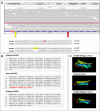Rare and potentially pathogenic variants in hydroxycarboxylic acid receptor genes identified in breast cancer cases
- PMID: 34852802
- PMCID: PMC8638184
- DOI: 10.1186/s12920-021-01126-3
Rare and potentially pathogenic variants in hydroxycarboxylic acid receptor genes identified in breast cancer cases
Abstract
Background: Three genes clustered together on chromosome 12 comprise a group of hydroxycarboxylic acid receptors (HCARs): HCAR1, HCAR2, and HCAR3. These paralogous genes encode different G-protein coupled receptors responsible for detecting glycolytic metabolites and controlling fatty acid oxidation. Though better known for regulating lipid metabolism in adipocytes, more recently, HCARs have been functionally associated with breast cancer proliferation/survival; HCAR2 has been described as a tumor suppressor and HCAR1 and HCAR3 as oncogenes. Thus, we sought to identify germline variants in HCAR1, HCAR2, and HCAR3 that could potentially be associated with breast cancer risk.
Methods: Two different cohorts of breast cancer cases were investigated, the Alabama Hereditary Cancer Cohort and The Cancer Genome Atlas, which were analyzed through nested PCRs/Sanger sequencing and whole-exome sequencing, respectively. All datasets were screened for rare, non-synonymous coding variants.
Results: Variants were identified in both breast cancer cohorts, some of which appeared to be associated with breast cancer BC risk, including HCAR1 c.58C > G (p.P20A), HCAR2 c.424C > T (p.R142W), HCAR2 c.517_518delinsAC (p.G173T), HCAR2 c.1036A > G (p.M346V), HCAR2 c.1086_1090del (p.P363Nfs*26), HCAR3 c.560G > A (p.R187Q), and HCAR3 c.1117delC (p.Q373Kfs*82). Additionally, HCAR2 c.515C > T (p.S172L), a previously identified loss-of-function variant, was identified.
Conclusions: Due to the important role of HCARs in breast cancer, it is vital to understand how these genetic variants play a role in breast cancer risk and proliferation and their consequences on treatment strategies. Additional studies will be needed to validate these findings. Nevertheless, the identification of these potentially pathogenic variants supports the need to investigate their functional consequences.
Keywords: And protein elongation; Breast cancer; G-protein coupled receptor; Genetic variants; Hydroxycarboxylic acid receptor.
© 2021. The Author(s).
Conflict of interest statement
The authors declare that they have no competing interests.
Figures




Similar articles
-
Invited review: nutrient-sensing receptors for free fatty acids and hydroxycarboxylic acids in farm animals.Animal. 2017 Jun;11(6):1008-1016. doi: 10.1017/S175173111600238X. Epub 2016 Nov 10. Animal. 2017. PMID: 27829484 Review.
-
Structural basis for ligand recognition of the human hydroxycarboxylic acid receptor HCAR3.Cell Rep. 2024 Nov 26;43(11):114895. doi: 10.1016/j.celrep.2024.114895. Epub 2024 Oct 19. Cell Rep. 2024. PMID: 39427321
-
Structures of G-protein coupled receptor HCAR1 in complex with Gi1 protein reveal the mechanistic basis for ligand recognition and agonist selectivity.PLoS Biol. 2025 Apr 15;23(4):e3003126. doi: 10.1371/journal.pbio.3003126. eCollection 2025 Apr. PLoS Biol. 2025. PMID: 40233099 Free PMC article.
-
Structural basis for ligand recognition and signaling of hydroxy-carboxylic acid receptor 2.Nat Commun. 2023 Nov 6;14(1):7150. doi: 10.1038/s41467-023-42764-8. Nat Commun. 2023. PMID: 37932263 Free PMC article.
-
Activation of HCAR2 by niacin: benefits beyond lipid lowering.Pharmacogenomics. 2019 Nov;20(16):1143-1150. doi: 10.2217/pgs-2019-0092. Epub 2019 Oct 16. Pharmacogenomics. 2019. PMID: 31617441 Review.
Cited by
-
Microarray-Based Prediction of Polycythemia after Exposure to High Altitudes.Genes (Basel). 2022 Jul 2;13(7):1193. doi: 10.3390/genes13071193. Genes (Basel). 2022. PMID: 35885976 Free PMC article.
-
Identification of Specific Biomarkers and Pathways in the Treatment Response of Infliximab for Inflammatory Bowel Disease: In-Silico Analysis.Life (Basel). 2023 Mar 2;13(3):680. doi: 10.3390/life13030680. Life (Basel). 2023. PMID: 36983834 Free PMC article.
-
HCAR3 and Kynurenic Acid in Cancer: A Promising Axis of Immunometabolic Regulation or a Scientific Mirage?Int J Mol Sci. 2025 Jun 28;26(13):6269. doi: 10.3390/ijms26136269. Int J Mol Sci. 2025. PMID: 40650047 Free PMC article. Review.
References
-
- Offermanns S. Hydroxy-carboxylic acid receptor actions in metabolism. Trends Endocrinol Metab. 2017;28(3):227–236. - PubMed
Publication types
MeSH terms
Substances
LinkOut - more resources
Full Text Sources
Medical
Molecular Biology Databases

